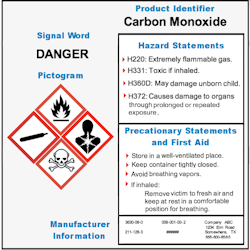Secondary (Workplace) Container Labeling
Most employers use the primary containers they purchase to store and use chemicals.
Employers may also use their own containers such as coffee cans, drums, plastic jugs, spray bottles, etc. to store and use smaller quantities of chemicals they purchase. These are called secondary, employer, or workplace containers.
The employer must ensure that each secondary container of hazardous chemicals in the workplace is labeled, tagged or marked with either the information required on shipped container labels or the following:
- Product Identifier - may be the common name of the chemical.
- Signal Word – This indicates the level of hazard associated with the chemical. "Warning" can also be used which would indicate a less severe hazard.
- Picotogram – Visually identifies the hazards associated with the chemical.
- Manufacturer Information – Name, address, phone number.
- Precautionary Statements/First Aid – Each statement is tied to a hazard statement and gives information regarding preventative measures and basic first aid.
- Hazard Statements – Phrases that describe the hazards and severity of the chemical.
Bottom line, the employer must ensure that employees still get all of the hazard information from the elements of the hazard communication program implemented in their workplaces that they would have gotten from a shipping label. To do this, the employer should conduct additional training, discuss SDS information, use signs, process sheets, or other types of warnings to supplement the secondary label information.
Knowledge Check Choose the best answer for the question.
2-5. Under OSHA rules, which of the following would be allowed for use as a secondary container?
You forgot to answer the question!

